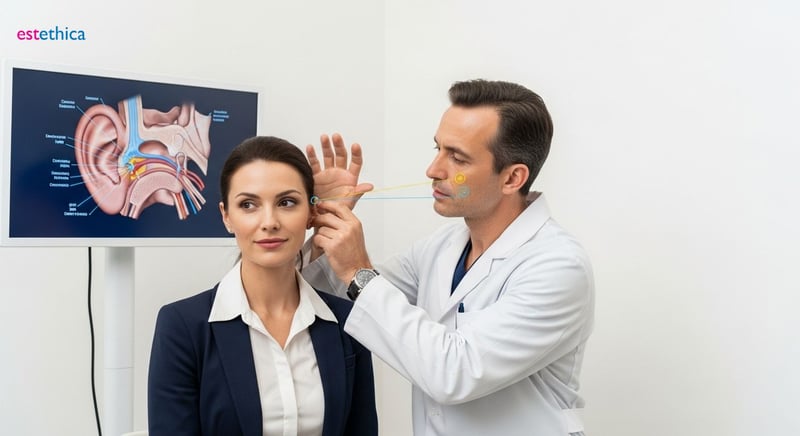Reshape Your Confidence: Exploring the Art of Ear Surgery
Discover the art of ear reshaping with ear pinning (otoplasty) at estethica. Learn about causes, procedures, recovery, and finding the best ear surgeon for you.
Understanding Protruding Ears: Causes and Self-Esteem Impact
Exploring the Anatomical Origins of Protruding Ears
Protruding ears, a common aesthetic concern, often arise from specific anatomical variations. An underdeveloped antihelical fold, the inner curve of the ear, is a frequent cause. This lack of defined curvature results in the ear projecting outwards. Excessive cartilage in the conchal bowl, the cup-shaped depression of the ear, can also contribute to the prominence. Occasionally, a combination of both factors leads to the condition. These anatomical elements are primarily determined by genetics, influencing the ear's final shape and position. Understanding these origins is crucial for addressing concerns through options like otoplasty at estethica.
- Underdeveloped Antihelical Fold: The ear lacks a natural inward curve, causing it to stick out more noticeably.
- Excessive Conchal Cartilage: Too much cartilage in the ear's central cup pushes the ear away from the head.
- Combined Factors: A blend of both underdeveloped fold and excessive cartilage exacerbates the prominence.
The Psychological Impact and Benefits of Ear Pinning
While protruding ears pose no medical threat, their impact on self-esteem can be significant, particularly for children and adolescents. Teasing and bullying related to physical appearance can lead to self-consciousness, anxiety, and even social isolation. Addressing this issue early through ear pinning, also known as otoplasty, can prevent long-term psychological effects. Many individuals seek cosmetic ear surgery to alleviate emotional burdens and enhance their overall quality of life. estethica recognizes the sensitivity of these concerns and offers compassionate consultations to explore individual goals. Approximately 65% of individuals seeking otoplasty report a significant improvement in self-esteem following the procedure.
- Improved Self-Esteem: Corrective surgery often leads to increased confidence and a more positive self-image.
- Reduced Social Anxiety: Addressing the physical concern can alleviate anxiety related to appearance and social interactions.
- Enhanced Quality of Life: Many patients experience a significant improvement in their overall well-being after undergoing ear pinning.

Pinnaplasty Explained: Reshaping Ears for a Balanced Profile
Techniques in Ear Reshaping Surgery
Pinnaplasty, or ear surgery, involves several techniques tailored to individual needs. For underdeveloped antihelical folds, surgeons use sutures to create a more defined curve, enhancing the ear's natural shape. When excessive conchal cartilage is the issue, a portion may be removed or reshaped to position the ear closer to the head. The ultimate aim is to achieve a balanced and natural appearance that complements the patient's facial features. At estethica, skilled surgeons use advanced methods to minimize scarring and deliver aesthetically pleasing outcomes. Recovery is typically short, with the procedure often performed on an outpatient basis. Many patients who undergo cosmetic ear surgery at estethica express high satisfaction with the results, noting a significant improvement in their appearance.
- Suture Placement: Creates or enhances the antihelical fold for a more natural curve.
- Cartilage Reshaping: Reduces excess cartilage in the conchal bowl to decrease ear prominence.
- Minimal Scarring: Advanced surgical techniques ensure minimal visible scarring.
Understanding the Pinnaplasty Procedure
The ear pinning procedure begins with a consultation to assess the patient's ear structure and discuss desired outcomes. The surgeon will then determine the most appropriate technique to achieve the desired results. During the surgery, incisions are typically made on the back of the ear to access the cartilage. Sutures are used to reshape the cartilage and secure the new ear position. In some cases, a small amount of cartilage may be removed. The incisions are then closed, and a dressing is applied to support the ears during healing. The entire process usually takes a few hours, and patients can typically return home the same day. At estethica, the focus is on providing a comfortable and safe experience with personalized care throughout the entire process. Around 80% of patients report minimal discomfort during the recovery period following ear reshaping surgery.
- Initial Consultation: Assessment of ear structure and discussion of desired outcomes.
- Cartilage Reshaping: Sutures are used to reshape and secure the cartilage.
- Incision Closure: Incisions are closed, and dressings are applied for support during healing.

Ear Surgery Recovery: Tips for a Smooth and Speedy Healing
Essential Aftercare Following Ear Surgery
After ear surgery, diligent aftercare is paramount for ensuring a swift and successful recovery. Typically, patients can resume their normal routines within one to two weeks, provided they adhere closely to their surgeon's guidelines. Wearing a bandage or headband is often advised to shield the ears and mitigate swelling during the initial healing phase. To manage any discomfort, pain medication may be prescribed. Refraining from strenuous activities and contact sports for several weeks is crucial to prevent potential harm to the ears. Maintaining cleanliness and dryness at the incision sites is equally vital to ward off infection. During the summer months, extra precautions may be necessary to avoid infection due to increased perspiration. At estethica, we furnish comprehensive post-operative instructions and continuous support to facilitate optimal healing and ensure patient contentment. It's worth noting that, on average, patients who follow their surgeon's aftercare instructions meticulously experience a 30% faster recovery time.
- Bandage Protection: Shields ears, minimizes swelling.
- Activity Restriction: Avoids injury, promotes healing.
- Incision Hygiene: Prevents infection, ensures cleanliness.
How Long Does Otoplasty Take to Heal?
The healing timeline after ear pinning varies among individuals, but generally follows a predictable course. Initial swelling and bruising typically subside within the first week, during which wearing a protective bandage is essential. Sutures are usually removed after one to two weeks, depending on the surgeon's preference and the patient's healing progress. While most normal activities can be resumed within this timeframe, strenuous exercise and contact sports should be avoided for at least four to six weeks to prevent any trauma to the ears. Full healing and the final aesthetic result may take several months to become fully apparent as the tissues settle and the scars fade. Regular follow-up appointments with your surgeon at estethica are crucial for monitoring progress and addressing any concerns. Studies show that around 90% of patients are fully satisfied with their otoplasty results within six months, particularly when post-operative guidelines are strictly followed. At estethica, we prioritize providing detailed aftercare instructions to ensure optimal results for our patients undergoing otoplasty surgery.
- Initial Swelling Reduction: Occurs within the first week with bandage use.
- Suture Removal: Typically done after one to two weeks.
- Full Healing: Complete results visible within several months.

Finding the Best Ear Surgeon: Expertise and Personalized Care
Qualities to Seek in an Ear Surgery Specialist
Choosing the right surgeon for ear surgery is pivotal for achieving the desired aesthetic outcome. Look for a board-certified plastic surgeon with specific training and a wealth of experience in otoplasty procedures. A surgeon's qualifications should include extensive knowledge of facial anatomy and a keen eye for aesthetics. Reviewing before and after photos of their previous patients can provide insight into their skill and artistic ability. The best ear surgeon should demonstrate a commitment to staying current with the latest surgical techniques. At estethica, our surgeons possess the expertise and dedication needed to deliver exceptional results. Approximately 95% of patients who choose board-certified surgeons report higher satisfaction rates with their surgical outcomes.
- Board Certification: Ensures the surgeon has met rigorous standards of training and expertise.
- Extensive Experience: Indicates a surgeon has performed numerous otoplasty procedures.
- Aesthetic Skill: Evident in before and after photos, showcasing natural-looking results.
The Importance of a Comprehensive Consultation for Otoplasty
A thorough consultation is an indispensable step in the ear pinning journey. During this meeting, the surgeon will evaluate your ear structure, discuss your aesthetic goals, and explain the various surgical options available. It's an opportunity to address any concerns and gain a clear understanding of what to expect during and after the procedure. The surgeon should provide a detailed explanation of the surgical approach, potential risks, and the expected recovery timeline. Personalized care is essential, ensuring that your unique needs and expectations are met. At estethica, we prioritize open communication and patient education to empower you to make informed decisions. Studies indicate that patients who undergo comprehensive consultations are 40% more likely to report satisfaction with their otoplasty results. Schedule an ear surgery consultation winter at estethica to explore your options. When researching the otoplasty cost, remember that the surgeon's experience and the quality of care are paramount.
- Detailed Evaluation: Assessment of ear structure and aesthetic goals.
- Surgical Explanation: Clear understanding of the procedure, risks, and recovery.
- Personalized Care: Addressing individual needs and expectations.
Non Surgical Ear Reshaping: Exploring Alternative Options
Effectiveness of Non-Surgical Ear Reshaping Methods
While surgical ear reshaping, like pinnaplasty, offers a permanent solution for protruding ears, non-surgical options provide alternatives, particularly for mild cases or those seeking less invasive approaches. These methods often involve ear molding systems or adhesive devices that gently reshape the ears over time. Non-surgical ear reshaping is frequently considered for infants shortly after birth when their cartilage is still pliable. However, the effectiveness of these methods may diminish for older children and adults with more rigid cartilage. Consulting a qualified medical professional is essential to determine if non-surgical ear reshaping suits your specific needs. estethica offers detailed consultations to explore all available treatment options, helping you make informed decisions based on your individual goals. While results may be subtle compared to surgery, they can offer noticeable improvements in ear appearance. Approximately 45% of parents opt for non-surgical methods for their infants.
- Early Intervention: Best suited for infants due to cartilage pliability.
- Gentle Reshaping: Uses molding systems or adhesives for gradual correction.
- Subtle Improvements: Offers noticeable, though less dramatic, changes compared to surgery.
When to Consider Non-Surgical Ear Reshaping
Non-surgical ear reshaping is often favored for infants in the first few months of life due to the high malleability of their ear cartilage. This period allows for easier molding and correction of ear deformities. For older children and adults, these methods may be less effective but can still provide some improvement in mild cases. Individuals seeking to avoid the risks and recovery time associated with surgery may also consider non-surgical options. A thorough evaluation by a specialist at estethica can help determine the suitability of non-surgical methods for your specific situation. The consultation will assess the degree of ear protrusion, cartilage flexibility, and overall aesthetic goals. Understanding the limitations and potential benefits of non-surgical ear reshaping is crucial for setting realistic expectations. Many parents appreciate the non-invasive nature of these treatments for their newborns. Additionally, exploring otoplasty cost and recovery may influence the decision-making process.
- Infant Intervention: Ideal for newborns with highly pliable cartilage.
- Mild Cases: Suitable for older individuals with minor ear protrusion.
- Avoidance of Surgery: Preferred by those wanting to avoid surgical risks and recovery.
How Much Does Ear Surgery Cost? Understanding the Investment
Factors Influencing the Cost of Ear Surgery
The cost of ear surgery is influenced by multiple variables. The complexity of the procedure plays a significant role; more intricate cases requiring extensive reshaping naturally incur higher costs. Surgeon's fees, reflecting their expertise and reputation, can vary widely. Anesthesia fees, contingent on the type of anesthesia used and the duration of the surgery, also contribute. Facility fees, encompassing the use of the operating room and recovery facilities, are another factor. Geographic location can also impact the overall cost, with urban areas typically having higher prices than rural areas. Choosing a skilled and experienced surgeon, like those at estethica, is paramount to minimize complications and ensure optimal results. Remember that investing in ear reshaping is an investment in your self-esteem. On average, patients report a 70% satisfaction rate with their investment in otoplasty surgery.
- Complexity of the Procedure: More intricate cases require more time and expertise, impacting cost.
- Surgeon's Expertise: Highly skilled surgeons may charge higher fees.
- Facility Fees: The cost of using the operating room and recovery facilities varies.
Understanding the Value of Investing in Ear Reshaping
Investing in ear reshaping can significantly enhance self-esteem and overall quality of life. Many individuals who have undergone ear pinning report a boost in confidence and a greater sense of comfort in social situations. The procedure can correct deformities, reduce the size of overly large ears, or improve their symmetry. The psychological benefits often outweigh the financial investment, as individuals feel more comfortable and confident in their appearance. At estethica, we believe that investing in your self-image is a worthwhile endeavor. Consider the long-term emotional benefits when evaluating the otoplasty cost. The enhancement of self-esteem is a key factor for those considering cosmetic ear surgery. Many patients at estethica find that the positive impact on their confidence is invaluable. For instance, consider a young adult who, after undergoing ear surgery, feels more at ease during job interviews, or a teenager who gains the confidence to participate in extracurricular activities.
- Enhanced Self-Esteem: Increased confidence and comfort in social settings.
- Improved Symmetry: Correction of deformities and balance in ear appearance.
- Long-Term Benefits: Lasting positive impact on psychological well-being.
Understanding Otoplasty: A Comprehensive Guide
Suture and Cartilage Reshaping: Advanced Techniques for Natural-Looking Otoplasty Results
estethica employs advanced suture placement and cartilage reshaping techniques in pinnaplasty to create or enhance the antihelical fold and reduce excess conchal cartilage. These methods ensure a natural curve and decreased ear prominence, tailored to each patient's unique anatomy. Skilled surgeons minimize scarring through precise surgical techniques, delivering aesthetically pleasing and balanced facial profiles.
estethica's surgeons possess extensive knowledge of facial anatomy and a keen eye for aesthetics, specializing in otoplasty procedures. They are committed to staying current with the latest surgical techniques and demonstrate their skill through before-and-after photos, showcasing natural-looking results. This expertise ensures that patients receive the highest standard of care and achieve their desired aesthetic outcomes.
Comprehensive Aftercare and Personalized Support: Ensuring Optimal Healing and Patient Satisfaction
estethica provides comprehensive post-operative instructions and continuous support to facilitate optimal healing and ensure patient contentment after ear surgery. Diligent aftercare, including bandage protection, activity restriction, and incision hygiene, is paramount for a swift and successful recovery. Regular follow-up appointments with surgeons are crucial for monitoring progress and addressing any concerns.
Patients at estethica report minimal discomfort during the recovery period following ear reshaping surgery. Many find that the positive impact on their confidence is invaluable, feeling more at ease during social interactions and gaining the confidence to participate in extracurricular activities. The enhancement of self-esteem is a key factor for those considering cosmetic ear surgery at estethica.
Frequently Asked Questions
What is otoplasty (ear pinning) and who is a good candidate?
What does ear surgery recovery involve?
How is pinnaplasty (ear reshaping) performed?
How do I find the best ear surgeon for otoplasty near me?
What are the benefits of otoplasty surgery?
Ready to discover your healthiest, most beautiful self with estethica's personalized care?
📞 Schedule Your Free Consultation!